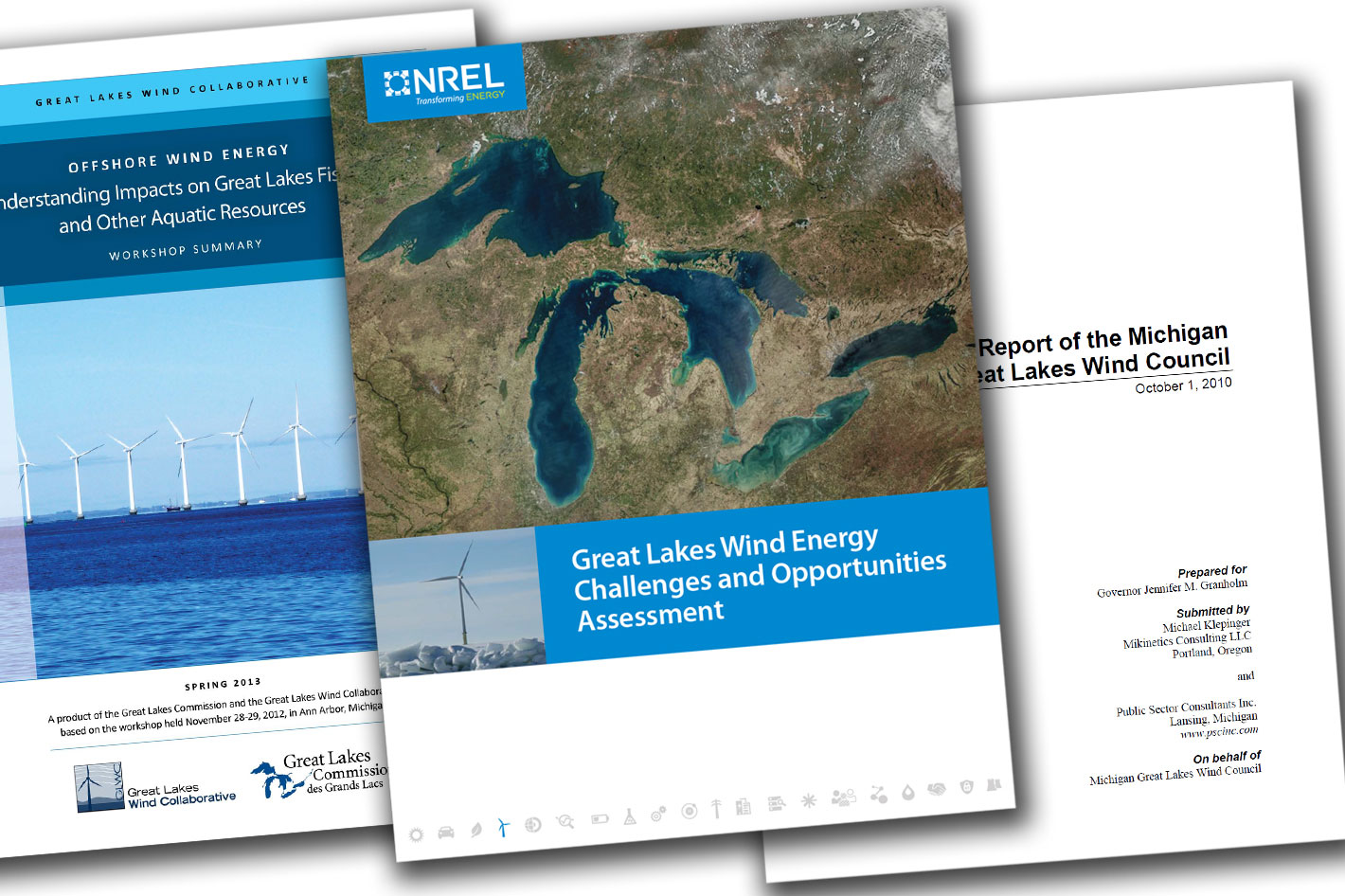A recent report on the advantages of wind energy in the Great Lakes continues to point to the benefits of its use but suggests 2035 as the year to launch offshore wind turbines in the Great Lakes.
The case for wind turbines in the Great Lakes is getting stronger, some suggest, but in fact, since 2009 that the installation of offshore wind farms has been discussed, without any real advancement. There was a time when some believed the Great Lakes, which represent a third coastline for the United States, would lead the way when it comes to wind turbines offshore, but the Atlantic coast of the United States has taken the first place when it comes to the development of wind turbines.
Created in January 2009, as an advisory body within the Michigan Department of Energy, Labor & Economic Growth, the Great Lakes Wind Council is responsible for examining issues and making policy recommendations related to offshore wind energy development in Michigan. The first report from the council, 70 pages long, published in September 2009, noted “that the placement of turbines in only a small fraction of the state’s Great Lakes could produce significant amounts of wind energy, making it possible to generate power in areas with few competing uses of the lakes.”
The report mentioned that “experience in European countries suggests that commercial fishing and offshore wind development are not incompatible as long as good planning takes place during the siting process” and adds that the Great Lakes support a valuable commercial fishery, dedicating a large part of the report to the specific precautions regarding the protection of the Great Lakes fisheries, which are an important part of the life of the Great Lakes. According to Michigan Sea Grant, recreational and commercial fishing are a vital part of Michigan’s heritage, with the fisheries valued in excess of $4-7 billion annually. Subsistence and tribal fishing, as well as aquaculture, also play important roles.
In 2013, the report “Offshore Wind Energy: Understanding Impacts on Great Lakes Fishery and Other Aquatic Resources” published by the Great Lakes Commission and the Great Lakes Wind Collaborative, and based on a workshop held on November 2012, notes that any public policy goals for wind energy offshore need to make sure that “clean, renewable energy, are compatible with, and when possible, even mutually supportive of policy goals to protect and enhance fisheries and related natural resources.” One prominent Great Lakes fishery biologist commented at the workshop: “If we don’t address climate change, we may not have any fish to worry about.”
The report notes that – at the time,” there is a lot of uncertainty regarding the impacts of wind turbines on fish movement, and influences will likely be different for migratory and non-migratory fish species” and adds that “a review article looking at all fish movement studies in the Great Lakes between 1952 and 2000 found that the majority of studies were related to non-native salmonids and a few on trout, walleye and sturgeon”, concluding that, regarding Lake Erie – used as an example – “the most favorable areas for OSW development, as defined by the Ohio Wind Turbine Placement Favorability Analysis, are where there is less fishing effort.”
In August 2020 a document published by the Citizens Campaign for the Environment, under the title Great Lakes Offshore Wind: Frequently Asked Questions, mentions that “the Block Island Wind Farm, the first and only operational U.S. wind farm, shows recreational boaters are safely navigating and fishing in and around wind turbines” and adds that “furthermore, the ‘reef effect,’ in which the offshore turbines create an artificial reef that attract fish and other wildlife, will potentially improve and benefit the recreational fishing industry in the Great Lakes.”
Despite plenty of reports, studies and opinions showing the potential of wind power, one thing is clear: the Great Lakes still don’t have any offshore turbines. But there is a new report, published in 2023, the 165 pages Great Lakes Wind Energy Challenges and Opportunities Assessment, which comes with a lot of numbers, and a goal that attracts attention: high-paying jobs and a cleaner environment!
The study, authored in part by the National Renewable Energy Laboratory (NREL), operated by Alliance for Sustainable Energy, LLC, for the U.S. Department of Energy (DOE), indicates “that the adoption of wind energy could enable states in this region to pursue their clean-energy goals while bolstering their economies with high-paying jobs and providing a cleaner environment for the local residents. The Great Lakes have an abundant wind resource near coastal population centers, and there is a real opportunity for it to contribute to the regional energy mix.”
The colloquial term “Third Coast” used to refer to the coastal regions of the Great Lakes appears in discussions about the implementation of offshore wind turbines, and that is easily explained: Michigan has more miles of shoreline than does any other of the lower 48 states, and the U.S. Great Lakes—which make up the largest freshwater system in the world— contain 20% of the planet’s freshwater resources. The five Great Lakes—Superior, Huron, Michigan, Erie, and Ontario, provide drinking water to more than 40 million people. And they hold, scientists add, a wealth of wind energy potential.
The numbers are clear: wind resource assessments estimate that the Great Lakes’ potential power capacity is 160 gigawatts for fixed-bottom wind turbines and about 415 gigawatts for floating wind energy systems. That wind energy resource potential exceeds the annual electricity consumption in five out of eight of the U.S. states bordering the Great Lakes.
The numbers do suggest that the potential is there, and the authors of the report believe that wind energy represents a significant opportunity for the Great Lakes region to transition to clean energy electrification and reap the associated benefits. The report now published, Great Lakes Wind Energy Challenges and Opportunities Assessment, defines a comprehensive research program to address these issues and charts a commercial pathway for wind energy in the Great Lakes that begins before 2035.
“Wind energy in the Great Lakes is compelling from both a clean energy and an economic growth standpoint,” said NREL researcher Walter Musial, a co-author of the report and the laboratory’s leading expert on offshore wind energy. “The Great Lakes have an abundant wind resource near population centers, and there is a real opportunity for Great Lakes wind energy resources to contribute not only to the region’s clean energy mix and its economic growth but also to achieving long-term national clean energy goals set by the administration.”
According to the report, “One of the most feasible economic benefits to Great Lakes offshore wind energy development is the potential to expand local logistics and supply chains. This includes the development and revitalization of factories, ports, and vessels that meet the needs of the new Great Lakes-based offshore wind energy industry.”
Commercial fishing is also mentioned, with a note that “Great Lakes wind energy development may also be constrained by various siting considerations, such as viewshed limits or export cable routing challenges, but also less constrained by some conventional offshore wind siting considerations, such as expansive commercial fishing…”
In fact, according to documents available from different sources, each of the Great Lakes supports commercial fishing, with fishing pressure varying spatially based on the habitats that each species prefers (GLWC 2013). Lake Erie is the most productive of the Great Lakes and almost always produces more fish than any of the others (Reutter 2019). Anglers target species in a range of habitats that extend from the shoreline to the Canadian border. Most commercial fishing in the Great Lakes is done with gill, trap, or fyke nets, although trawls are used in certain places (e.g., Michigan Sea Grant 2022a; NYSERDA 2022a).
There are many other obstacles that these projects face, from the difficulty in transporting the offshore wind turbines to their destination to construction choices, either fixed-bottom foundation or floating wind turbines. Another big challenge is freshwater ice, which is stronger than sea ice and more prevalent in the Great Lakes than in Atlantic offshore wind energy sites. The lakes’ annual freshwater surface ice introduces new technological challenges, especially for floating wind turbines, which have not yet been proven under these conditions.
“We don’t think developing floating wind turbines in icy climates will be a massive hurdle, but it hasn’t been done before, so there is a significant amount of uncertainty,” Musial said. Depending on the lake, floating offshore wind turbines could have advantages over fixed-bottom turbines, according to Musial.
The study indicates that further targeted research is needed to develop an informed Great Lakes wind energy strategy. The NREL research team’s preliminary recommendations to enable deployment of offshore wind in the Great Lakes by 2035 include:
- Assessing site characterization, wind resource, lakebed features, and ice conditions
- Evaluating the capabilities and needs of ports and vessels for installation and maintenance
- Determining how to develop a regional supply chain
- Assessing technology options, capabilities, and needs, including both fixed-bottom and floating systems
- Examining ways to engage the workforce needed to support the development and ongoing maintenance of this new industry
- Estimating project costs
- Developing strategies to monitor and minimize environmental impacts, such as collision risk to birds and bats
- Assessing human-use impacts, including examining viewshed and collaborating with fisheries
- Evaluating regulatory and policy considerations in each state, including offshore leasing processes
- Investigating electric power network points of interconnection, power handling capacity, and transmission expansion plans and needs
- Researching prospective opportunities and synergies with Canadian entities.
“The Great Lakes offer vast opportunities for offshore wind development, and our research is just a starting point,” Musial said. “While there are obstacles to any offshore wind deployment, the Great Lakes’ challenges are unique and need to be addressed. Yet, our study identified no insurmountable barriers that would ultimately render Great Lakes wind energy unfeasible.”
Despite all the good things the report suggests offshore wind turbines may bring to the Great Lakes, opposition to the projects continues to be a reality. You would think that conservationists would all unite against a project that some suggest will destroy the Great Lakes forever, but an article in Scientific American notes that even “environmental organizations have been split on this issue.”
If you search online for “offshore wind turbines, Great Lakes” you’ll find titles as “Wind Farms Cause More Environmental Impact Than Previously Thought”, “Wind farm in the Great Lakes? Big potential meets big opposition” or “Lake Erie Wind Farm Divides Environmental Activists”. Still, there may be a shift in the tone, as a more recent article, from April, under the title “Environmentalists, unions back latest push for offshore wind on Lake Michigan” reveals that “lawmakers are currently considering legislation to create a regulatory framework for offshore wind while directing the state to seek federal funding and a developer for the Lake Michigan project, which would need to be online by the end of 2030.”
Still, the controversy continues. Only three months before the article mentioned above, the Buffalo News had this title: “Study, amid groundswell of opposition, shelves idea of wind turbines in Lake Erie: 'Now is not the right time'”.
It’s not easy to navigate through all these news, some of them contradictory. In April 2022 the website electrek published an article, “The first US offshore wind farm has had no negative effect on fish, finds groundbreaking study” noting that “a seven-year-long study, the first of its kind in the United States, titled, “Demersal fish and invertebrate catches relative to construction and operation of North America’s first offshore wind farm,” was published in the ICES Journal of Marine Science on March 29.” Follow the link above to read the entire article.







